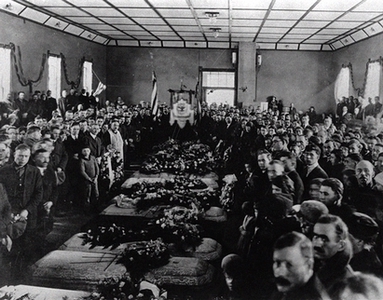CASTLE GATE MINE DISASTER

Funeral Mass for Castle Gate Greek miners
Governor Charles R. Mabey formed a committee to distribute $132,445.13 collected publicly for the aid of the 417 individuals who were left without support following the disaster. The committee hired one of the first social workers in the country, Annie D. Palmer, to assess needs and disburse funds. A granite and bronze monument is located in the canyon north of Helper to mark the general location of the mining accident; the Castle Gate cemetery east of the canyon contains many of the victims' graves.
See: Allan Kent Powell, The Next Time We Strike: Labor in the Utah Coal
Fields, 1900-1933 (1985); Saline Hardee Fraser, "One Long Day That
Went on Forever," Utah Historical Quarterly 48 (1980); Michael
Katsanevas, Jr., "The Emerging Social Worker and the Distribution of
the Castle Gate Relief Fund, "Utah Historical Quarterly 50 (1982);
and Janeen Arnold Costa, "A Struggle for Survival and Identity: Families
in the Aftermath of the Castle Gate Mine Disaster," Utah Historical
Quarterly 56 (1988).
Disclaimer: Information on this site was converted from a hard cover book published by University of Utah Press in 1994. Any errors should be directed towards the University of Utah Press.